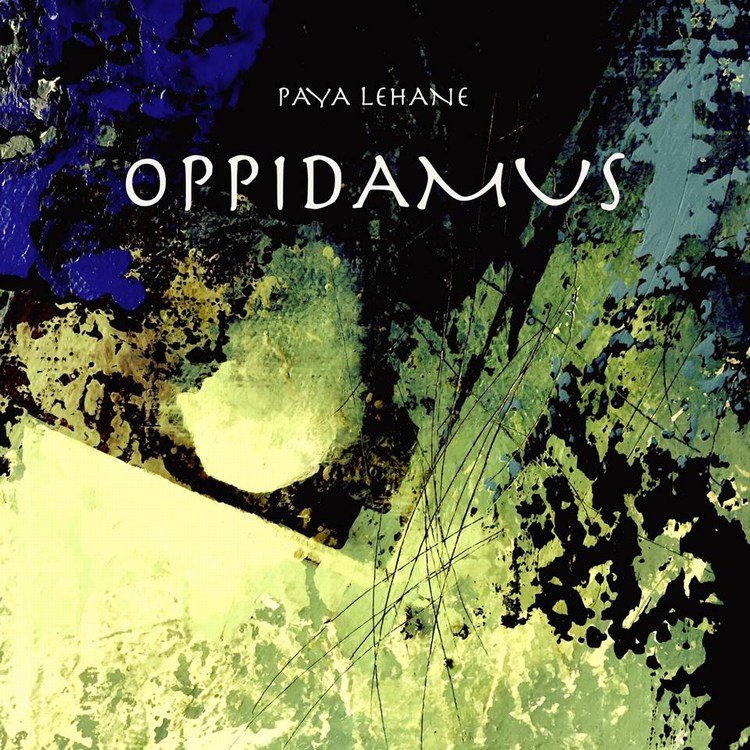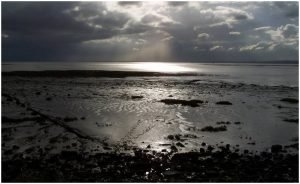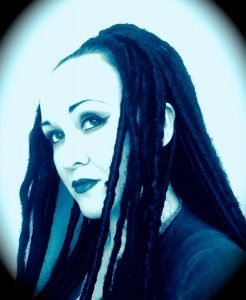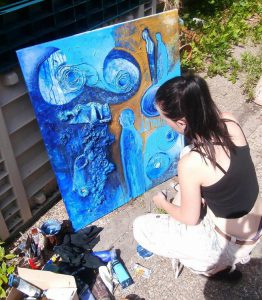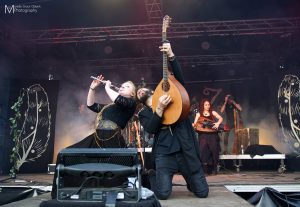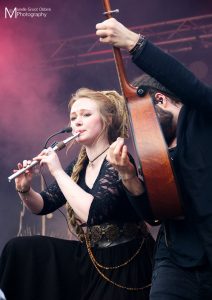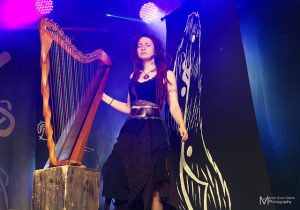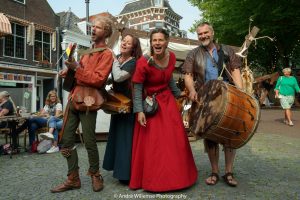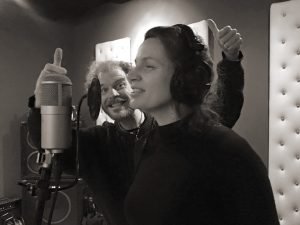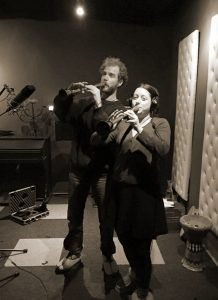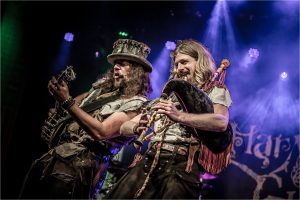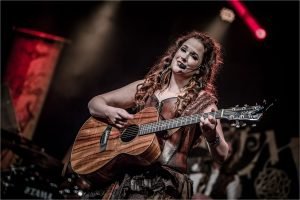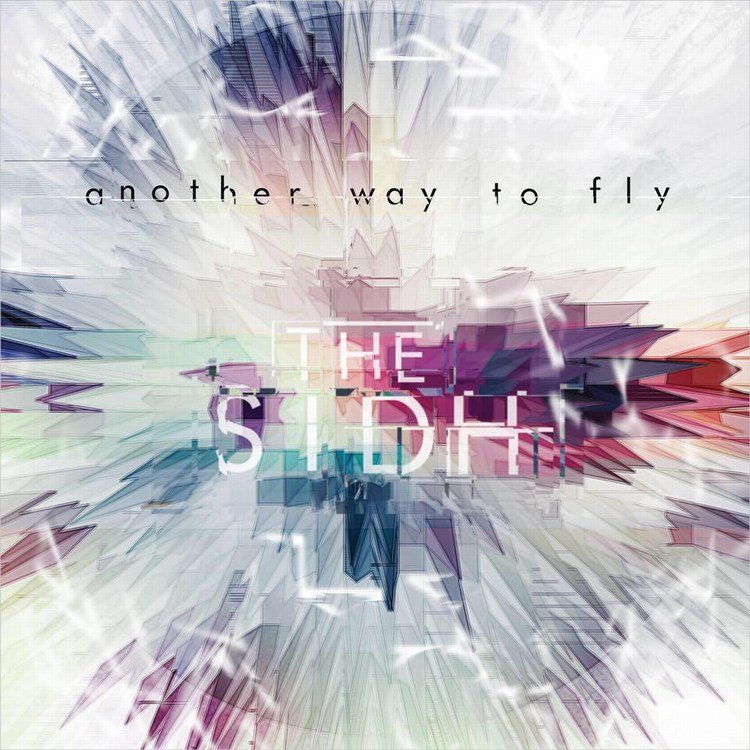
Every now and again Alex and Arjan, the founding fathers of CeltCast, like to throw a curveball at me. But when Alex pushed the Sidh‘s Another Way To Fly CD in my hands, saying he would love me to write a review on it, I felt seriously out of my comfort zone. Not that I suspected the music to be bad, 5000 plus people going nuts while watching the Sidh turn Castlefest into one big dance party can’t be wrong. No, it’s more that I’m a hardrock/metalhead at heart and when I was young, you either where ‘metal’ or ‘gabber’. The two didn’t mix that well. Only occasionally did I pick up on some dance acts, the latest ones being The KLF, Daft Punk, Dance 2 Trance and Faithless, all ’90’s Eurodance/trance acts. You can safely say the whole electronic dance scene passed by, without me paying attention to it. To get a dubstep album pushed into my hands, even if it has folk elements in it,…well…Let’s say I needed some convincing.
And boy did the Sidh convince me, did they ever!
 But first I had to figure out what that was, dubstep??? So I spent a nice couple of hours on Wikipedia and YouTube doing research.
But first I had to figure out what that was, dubstep??? So I spent a nice couple of hours on Wikipedia and YouTube doing research.Dubstep started in London’s underground dance scene around 1998. UK Garage deejays started mixing their dance music with reggae style rhythms and percussion. First it was dub remixes that went on B-sides of singles, (versions of the songs without the vocals.), later it became a style of its own. The early UK style dubstep was relatively slow and really reggae like in feel. Just as in reggae the bass lines and percussion rhythms were inregular and broken, with the emphasis on the uneven beats, especially the third, although you almost won’t hear that on Another Way To Fly. What you will hear, is another feature of early dubstep, a real low, pumping sub-bass sound, or as a early flyer once said: ‘A bass sound to make your chest cavity shudder.’
In 2005 dubstep was getting mainstream, being picked up by two BBC DJ’s. Around that time some dubstep producers started to work less with sub-bass and more with mid-range sounds. One of them, Rusko, was influenced by Swedish and Finnish producers who had a dance style with simple synthesizer leads and basslines with funk, r&b or soul rhythms, a sound that has become known as Skweeee (yep, really, no kidding.)
American producers picked up on this new style of dubstep and added robotic vocal effects and metal-like riffs, producing a way more aggressive sort of dubstep, normally called brostep. Skrillex is one of the best known producers of this style of dance music. Listening to the music on Another Way To Fly I would say it is mostly influenced by this later UK and American style.
 Getting back to the Sidh, they are an Italian band, with an interesting line up for a dance act. It starts with Federico Melato. As it is to be expected he plays the synthesizer, but also piano and percussion. Michael Subet plays the bass, also not that weird in a dance act. But then we have Salvatore Pagliaro on guitar and Iain Marr on whistles, bagpipes (?!) and guitar. That is what makes the Sidh stand out. They are as much a live band as they are a dance-act, and you can hear that in their music.
Getting back to the Sidh, they are an Italian band, with an interesting line up for a dance act. It starts with Federico Melato. As it is to be expected he plays the synthesizer, but also piano and percussion. Michael Subet plays the bass, also not that weird in a dance act. But then we have Salvatore Pagliaro on guitar and Iain Marr on whistles, bagpipes (?!) and guitar. That is what makes the Sidh stand out. They are as much a live band as they are a dance-act, and you can hear that in their music. In 2012 their first CD Follow The Flow came out. A nice album where the Sidh first introduced their own unique style of dance music. You can hear the band experiment with the energetic Irish folk music on one side, and the English style dubstep beats on the other. Despite the electronics used, it has an open, in parts acoustic-, sometimes even a rock feel. It’s as if Soar patrol‘s guitarist Steve Legget and piper Chick Allen stepped in the studio with Harmony Glen‘s flutist/piper Gilian Hettinga and they would have Rusko as a producer.
The second album Nitro came out in 2014. On this album the Sidh managed to further blend the two different styles together, leaving us with eight upbeat folk/dance songs and one lovely instrumental ballad called Believe. (you have to look up that song, it is beautiful) Compared to Another Way To Fly, Nitro still sounds really open, Mostly because Iain uses the flute as his main solo instrument, just occasionally the bagpipe comes out.
 Now there is the third CD, Another Way To Fly. And where Nitro sounded happy this CD really kicks you in the butt. The folk influences are just as Irish and cheerful as on previous albums, but the dubstep beats pack a real punch this time, taking the best of the heavy American brostep style and the old skool UK sub-bass beats.
Now there is the third CD, Another Way To Fly. And where Nitro sounded happy this CD really kicks you in the butt. The folk influences are just as Irish and cheerful as on previous albums, but the dubstep beats pack a real punch this time, taking the best of the heavy American brostep style and the old skool UK sub-bass beats. Those beats are immediately apparent in the opening song Shake That Bagpipe. It starts with a pumping baseline, followed by Iain’s whistle kicking off the first Irish tune. After that the Sidh throw everything but the kitchen sink at you, flute, bagpipe, breaks, slow dubstep sections, cool percussion, fast pumping basslines, catchy hooks, and all that in just 3:48 minutes. This is a wake-up call, as strong as two litres of Italian expresso. No way you are gonna sit still on this song!
Now that we are awake The Silk Road ‘eases’ us into the album. It starts in a way that is reminiscent of the Sidh’s first CD. A calm intro with acoustic guitar and a friendly flute tune, the bassline doesn’t ‘kick in’ this time but blends in and the string section helps to make this a mellow midtempo song, getting you in the flow of the album after the mindboggling start of it. It is, aside from the beats, a really lovely Irish tune. The Sidh carefully build layer upon layer to tell a musical story, proving that electronic dance music isn’t always a bunch of beats thrown together, but can be beautiful and touching as well. It’s also one of the few songs that are only leaning on the flute. The Sidh have discovered the raw power of the bagpipe and are using it to its full potential on Another Way To Fly. It’s the leading melodic instrument in almost all of the 14 songs.
The third song, Khan, picks up on The Silk Road‘s theme with Marcin Ruminski doing some impressive, Mongolian style throat singing. Marcin is the founder, vocalist and whistler of the Polish folk band Shannon. Again it’s a catchy tune telling a story, the sound of the melody reminding me of an old Italian space synth band I used to like called Koto. It is a nice upbeat song, although I have to say, after the really strong intro with the big drums and the throat singing, I was hoping for a wee bit more adventurous middle section with more of a Mongolian feel and instruments. Now the Sidh drop back to ‘just’ bagpipe and flute. Why not go all the way? It would make the album more varied and therefore even stronger.
 By the time we get to the fourth song Alba, it’s clear what the recipe for a good the Sidh composition is. It starts with nice catchy intro, mostly with flute, then the beats kick in. The intro becomes the hook where the song is built around. One or two breaks are build in to open up the music and make the beats sound stronger. And under it all there is always that powerful combination of sub low bass and bagpipe. It may sound a bit dull written out like this, but not to worry, the Sidh do this so well.
The power of this this recipe is in the quality of the melodies used. They are well composed, full-on Irish folk tunes. Iain is a gifted flute and bagpipe player and he is fast, seriously fast. Quite often he equals
Perkelt‘s
Paya Lehane
in speed. Impressive stuff. Where the American brostep style focusses on aggression, the Sidh bring something new to it, positive vibes. You hear the heritage of the old Italo-disco sound in there, and the folk tunes are the perfect way to carry that through.
By the time we get to the fourth song Alba, it’s clear what the recipe for a good the Sidh composition is. It starts with nice catchy intro, mostly with flute, then the beats kick in. The intro becomes the hook where the song is built around. One or two breaks are build in to open up the music and make the beats sound stronger. And under it all there is always that powerful combination of sub low bass and bagpipe. It may sound a bit dull written out like this, but not to worry, the Sidh do this so well.
The power of this this recipe is in the quality of the melodies used. They are well composed, full-on Irish folk tunes. Iain is a gifted flute and bagpipe player and he is fast, seriously fast. Quite often he equals
Perkelt‘s
Paya Lehane
in speed. Impressive stuff. Where the American brostep style focusses on aggression, the Sidh bring something new to it, positive vibes. You hear the heritage of the old Italo-disco sound in there, and the folk tunes are the perfect way to carry that through.Alba is a good example of how cool a dancetrack can be, played the Sidh way, a mellow upbeat Italo-disco/trance melody on flute or synth, with the low bassline and bagpipe under it to give it some oomph. One of my favourite songs on the album.
And so we come to my favourite song on Another Way To Fly. The best song of the Sidh in general I think. One of my favourite songs of the last few months actually, IRIDIUM!
It starts with an impressive synthesizer organ creating a wall of chords. When, in the second bar, the bagpipe and bass join in, this wall of chords just blow you away. The song is built around a cool bagpipe hook, catchy as anything. I just love that hook and, oh joy (!), they keep repeating it! again and again! it’s just magic! When the electric guitar kicks in, shooting off fast metal riffs I’m already gone..No stopping me getting to that dancefloor. What a song. Haven’t heard such a strong dancefloor filler since the KLF’s Last Train To Trancentral. Love it!
After this wall of sound we get our first breather. I Can’t Let Go is a ballad sung by the second guest musician Tim Chaisson. He is a Canadian folk/pop singer songwriter. I Can’t Let Go shows the sensitive side of The Sidh. Two suggestions came up while listening to this song. First I would have loved the song to be a bit longer. It stops rather unexpectedly and abrupt. Secondly, after the adrelin rush caused by Iridium, I personally would have loved to dance a bit more, before having this breather. Around song nine I would say. But i’m nitpicking now, I Can’t Let Go is a lovely song with a quality singer, no question about it.
 The pace is picked up again with Sileadh and Vault. More cool bagpipe folk hooks with upbeat flute solo’s cutting through the wall of sound. The feel of folk- and trance chords cheering you up, as the dubstep bass makes sure you don’t stop dancing for a second.
The pace is picked up again with Sileadh and Vault. More cool bagpipe folk hooks with upbeat flute solo’s cutting through the wall of sound. The feel of folk- and trance chords cheering you up, as the dubstep bass makes sure you don’t stop dancing for a second. I have to say, I love this album. I really do. My only wish for the next album is that the band go a bit bolder with the production. With a sound as orchestral as Another Way To Fly, I would have loved to have had more surprises in the production to keep me on my toes. The ultra heavy metal-guitar-with-low-bass-break in Vault for instance. How cool would it have been if those riffs had been shooting in my ears from left to right . I think I would have gone mental if they had done that. Don’t get me wrong. It is a heavy song as it is and on a brilliant album but treats like that would have been the icing on the cake.
Well there is nothing more to say really, besides that the Scottish piper and folk composer Ross Ainslie joins the Sidh on Heroes and that Goldie’s Goldie seems to be a homage the flute builder Colin Goldie. He makes the flutes Iain Marr plays on and is featured on this song.
Another Way To Fly is the Sidh’s strongest album till now in my opinion. The band has found the perfect blend between all the different influences, making it their own in a style I would call Sidh-step! If you are just as much at home on the dancefloor, as you are on the Castlefest fields, then this is the CD for you. The ‘Sidhstep’ dance they play will get you going time and time again. If big beats are not your thing, you might want to check their first album Follow The Flow. It’s a ‘lighter’ dance album. More flute, more folk orientated with less of the heavy powerbeats. More the old skool dubstep and therefore easier to listen to.
And what about me, the old metalhead? Well I’m converted. I’m so glad Alex put this CD in my hands and pushed me out of my comfort zone. The Sidh definitely got me hooked on the dubstep sound. Thanks guys for opening up another musical world to me.

Cliff
editor:
Diane
photo Credits:
Photographer Ruben Meuwese.
First picture taken at Keltfest 2018, other pictures taken at Castlefest 2018.
All pictures posted with kind permission of Vana Events.
